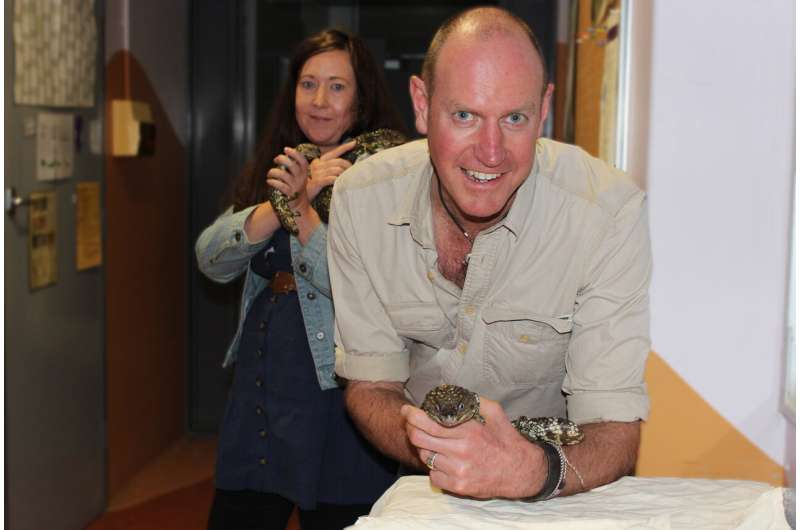Lizard legacy sheds new light on web of life

A special issue of Austral Ecology this month is celebrating the legacy of an internationally renowned South Australian ecologist, whose work inspired a new generation of scientists and launched a momentum to ensure the survival of his beloved lizards, contribute enormously to their understanding, and enrich ecology knowledge at a broader level.
During more than 30 years at Flinders University, Professor Mike Bull established one of the longest running studies on lizards in the Southern Hemisphere—now in its 39th year—a survey in the mid-north of South Australia monitoring sleepy lizards. He authored over 300 peer reviewed papers and was one of Australia's foremost experts in behavioral ecology until his unexpected death in 2016.
Austral Ecology—a journal Professor Bull edited for 25 years—published 12 new studies this month that are testament to his legacy, most from previous students and colleagues at Flinders University.
Together, these represent a vast progression in knowledge on species like South Australia's endangered pygmy bluetongue and iconic sleepy lizard, and share new insights on the roles of parasites, bacteria, environmental change, chemical communication and more—to lizards ecology and ecosystems more broadly.
Associate Professor Mike Gardner worked with Professor Bull and now leads lizard research at Flinders University.
"Mike Bull had a 'brick on brick' approach, he'd investigate a problem, then use the results to inform the next question, and repeat," he says.
Professor Bull's major discovery was long-term monogamy in the sleepy lizard (Tiliqua rugosa), which sparked much research into lizard sociality.
"He often looked at skinks closely related to sleepy lizards to investigate sociality, which is furthered by four studies in this special issue," Associate Professor Gardner says.
One of these examines the influence of aridity and cold on group sizes of the spiny tailed skink, finding groups to be larger in arid environments and on cold days, highlighting how behavior responds to environmental variation. United in adversity: Aridity and cold influence aggregation behavior in a social lizard, Egernia stokesii
Another study identified the importance of lizard scat (feces) as a social signal, with the size of a pile next to a crevice and its origin (own vs another) influencing a gidgee skink's choice of refuge—shedding light on the species' feces-piling habit while highlighting the role of chemicals in communication. Scat on the doorstep: Refuge choice in a group-living lizard is influenced by the presence of scat piles
"Mike saw his work on the conservation of pygmy bluetongues as his main legacy," says Associate Professor Gardner, who received a $400,000 ARC grant this year to help save the species. Early studies that established this five-year translocation project are reported on in the issue.
"These include one that examined the effect of sheep population density on grazing land." (The lizard's sole habitat). Effects of grazing regime on the relative body mass of the endangered pygmy bluetongue lizard (Tiliqua adelaidensis )
"Grazing intensity was found to increase with the lizard's body size, but the size of grasshoppers was found to be another key factor."
Another examined life stage best suited to translocation, finding adult pygmy bluetongues more likely to thrive given 'risky' behaviors of juveniles that make them prone to predators. Translocation for conservation: Neonates are less suitable than adults
Another study investigated the occupancy of spider burrows by these lizards, who commonly use them as refuges or ambush sites. Usually pygmy bluetongues preferred to be on their own, but this study found many species including snails, centipedes and weevils co-existed, particularly in the burrows of wolf spiders, and that co-existance has seasonal variation. Understanding shared burrow use is important to long-term conservation, as burrow availability is crucial to pygmy lizards' survival. Co-occupancy of spider-engineered burrows within a grassland community changes temporally
The special issue also broke the discovery of a new species of mite found on pygmy bluetongue hosts.
"Parasites were probably the biggest single interest of Mike's career, and this new species has appropriately been named Ophiomegistus michaeli," says Associate Professor Gardner.
"In particular, Mike built our understanding of two tick species; Bothriocroton hydrosauri and Amblyomma limbatum, wanting to understand why an invisible boundary in the mid north of South Australia separates their existence on sleepy lizards."
This elusive question was not resolved in Professor Bull's lifetime, but new research this month suggests bacteria potentially play a part. Proposing a new hypothesis: Rickettsia spp. as a mechanism maintaining parapatry between two Australian reptile tick species
Another study co-authored by Associate Professor Gardner's laboratory assistant Dr. Jess Clayton, a previous student of Professor Bull, examined how one of these ticks was transmitted among sleepy lizards, finding parasite transmission is influenced by lizard refuge use and proximity, but environmental conditions also play a role. Spatial proximity and asynchronous refuge sharing networks both explain patterns of tick genetic relatedness among lizards, but in different years
"What we're learning through these multiple studies connects the pieces to form a much bigger picture," Dr. Clayton says.
"It's wonderful to be a part of this journey and continue Professor Bull's methodical approach to build a vast collection of knowledge, with conservation the end goal."
More information: Austral Ecology, onlinelibrary.wiley.com/toc/14429993/2020/45/4
Provided by Flinders University


















